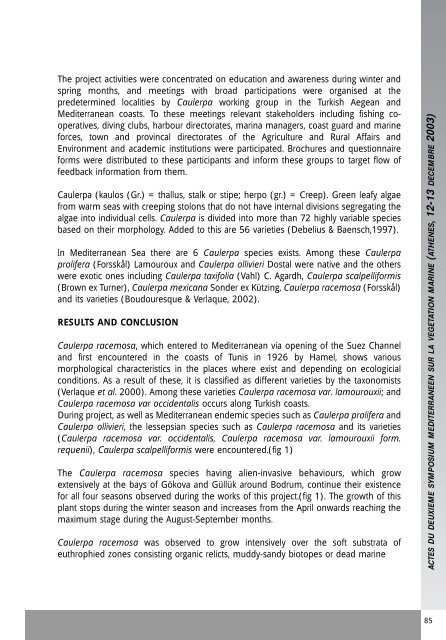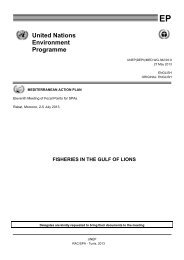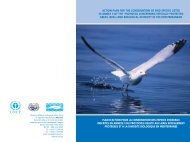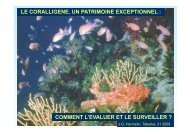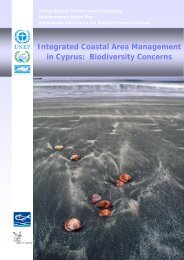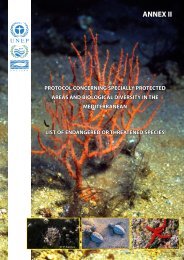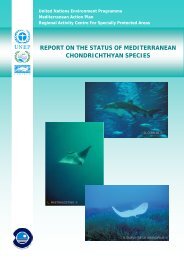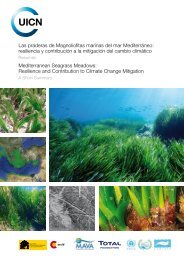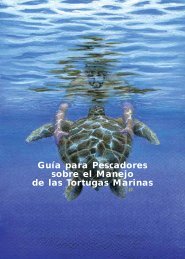Proceedings of the Second Mediterranean Symposium on Marine
Proceedings of the Second Mediterranean Symposium on Marine
Proceedings of the Second Mediterranean Symposium on Marine
You also want an ePaper? Increase the reach of your titles
YUMPU automatically turns print PDFs into web optimized ePapers that Google loves.
The project activities were c<strong>on</strong>centrated <strong>on</strong> educati<strong>on</strong> and awareness during winter and<br />
spring m<strong>on</strong>ths, and meetings with broad participati<strong>on</strong>s were organised at <str<strong>on</strong>g>the</str<strong>on</strong>g><br />
predetermined localities by Caulerpa working group in <str<strong>on</strong>g>the</str<strong>on</strong>g> Turkish Aegean and<br />
<str<strong>on</strong>g>Mediterranean</str<strong>on</strong>g> coasts. To <str<strong>on</strong>g>the</str<strong>on</strong>g>se meetings relevant stakeholders including fishing cooperatives,<br />
diving clubs, harbour directorates, marina managers, coast guard and marine<br />
forces, town and provincal directorates <str<strong>on</strong>g>of</str<strong>on</strong>g> <str<strong>on</strong>g>the</str<strong>on</strong>g> Agriculture and Rural Affairs and<br />
Envir<strong>on</strong>ment and academic instituti<strong>on</strong>s were participated. Brochures and questi<strong>on</strong>naire<br />
forms were distributed to <str<strong>on</strong>g>the</str<strong>on</strong>g>se participants and inform <str<strong>on</strong>g>the</str<strong>on</strong>g>se groups to target flow <str<strong>on</strong>g>of</str<strong>on</strong>g><br />
feedback informati<strong>on</strong> from <str<strong>on</strong>g>the</str<strong>on</strong>g>m.<br />
Caulerpa (kaulos (Gr.) = thallus, stalk or stipe; herpo (gr.) = Creep). Green leafy algae<br />
from warm seas with creeping stol<strong>on</strong>s that do not have internal divisi<strong>on</strong>s segregating <str<strong>on</strong>g>the</str<strong>on</strong>g><br />
algae into individual cells. Caulerpa is divided into more than 72 highly variable species<br />
based <strong>on</strong> <str<strong>on</strong>g>the</str<strong>on</strong>g>ir morphology. Added to this are 56 varieties (Debelius & Baensch,1997).<br />
In <str<strong>on</strong>g>Mediterranean</str<strong>on</strong>g> Sea <str<strong>on</strong>g>the</str<strong>on</strong>g>re are 6 Caulerpa species exists. Am<strong>on</strong>g <str<strong>on</strong>g>the</str<strong>on</strong>g>se Caulerpa<br />
prolifera (Forsskål) Lamouroux and Caulerpa ollivieri Dostal were native and <str<strong>on</strong>g>the</str<strong>on</strong>g> o<str<strong>on</strong>g>the</str<strong>on</strong>g>rs<br />
were exotic <strong>on</strong>es including Caulerpa taxifolia (Vahl) C. Agardh, Caulerpa scalpelliformis<br />
(Brown ex Turner), Caulerpa mexicana S<strong>on</strong>der ex Kützing, Caulerpa racemosa (Forsskål)<br />
and its varieties (Boudouresque & Verlaque, 2002).<br />
RESULTS AND CONCLUSION<br />
Caulerpa racemosa, which entered to <str<strong>on</strong>g>Mediterranean</str<strong>on</strong>g> via opening <str<strong>on</strong>g>of</str<strong>on</strong>g> <str<strong>on</strong>g>the</str<strong>on</strong>g> Suez Channel<br />
and first encountered in <str<strong>on</strong>g>the</str<strong>on</strong>g> coasts <str<strong>on</strong>g>of</str<strong>on</strong>g> Tunis in 1926 by Hamel, shows various<br />
morphological characteristics in <str<strong>on</strong>g>the</str<strong>on</strong>g> places where exist and depending <strong>on</strong> ecologicial<br />
c<strong>on</strong>diti<strong>on</strong>s. As a result <str<strong>on</strong>g>of</str<strong>on</strong>g> <str<strong>on</strong>g>the</str<strong>on</strong>g>se, it is classified as different varieties by <str<strong>on</strong>g>the</str<strong>on</strong>g> tax<strong>on</strong>omists<br />
(Verlaque et al. 2000). Am<strong>on</strong>g <str<strong>on</strong>g>the</str<strong>on</strong>g>se varieties Caulerpa racemosa var. lamourouxii; and<br />
Caulerpa racemosa var occidentalis occurs al<strong>on</strong>g Turkish coasts.<br />
During project, as well as <str<strong>on</strong>g>Mediterranean</str<strong>on</strong>g> endemic species such as Caulerpa prolifera and<br />
Caulerpa ollivieri, <str<strong>on</strong>g>the</str<strong>on</strong>g> lessepsian species such as Caulerpa racemosa and its varieties<br />
(Caulerpa racemosa var. occidentalis, Caulerpa racemosa var. lamourouxii form.<br />
requenii), Caulerpa scalpelliformis were encountered.(fig 1)<br />
The Caulerpa racemosa species having alien-invasive behaviours, which grow<br />
extensively at <str<strong>on</strong>g>the</str<strong>on</strong>g> bays <str<strong>on</strong>g>of</str<strong>on</strong>g> Gökova and Güllük around Bodrum, c<strong>on</strong>tinue <str<strong>on</strong>g>the</str<strong>on</strong>g>ir existence<br />
for all four seas<strong>on</strong>s observed during <str<strong>on</strong>g>the</str<strong>on</strong>g> works <str<strong>on</strong>g>of</str<strong>on</strong>g> this project.(fig 1). The growth <str<strong>on</strong>g>of</str<strong>on</strong>g> this<br />
plant stops during <str<strong>on</strong>g>the</str<strong>on</strong>g> winter seas<strong>on</strong> and increases from <str<strong>on</strong>g>the</str<strong>on</strong>g> April <strong>on</strong>wards reaching <str<strong>on</strong>g>the</str<strong>on</strong>g><br />
maximum stage during <str<strong>on</strong>g>the</str<strong>on</strong>g> August-September m<strong>on</strong>ths.<br />
Caulerpa racemosa was observed to grow intensively over <str<strong>on</strong>g>the</str<strong>on</strong>g> s<str<strong>on</strong>g>of</str<strong>on</strong>g>t substrata <str<strong>on</strong>g>of</str<strong>on</strong>g><br />
euthrophied z<strong>on</strong>es c<strong>on</strong>sisting organic relicts, muddy-sandy biotopes or dead marine<br />
ACTES DU DEUXIEME SYMPOSIUM MEDITERRANEEN SUR LA VEGETATION MARINE (ATHENES, 12-13 DECEMBRE 2003)<br />
85


